|
|
|
|
Products mentioned in this Article
--None--
|
|
|
|
|
|
|
|
|
 |
|
|

|
Reviews:
September 2014
Our regular, monthly round-up of what's new on the hobby scene.
Enjoy!
|
| Lancashire Games have been stalwarts of the UK wargaming scene for many years now, and ran quite a successful pre-ordering campaign in the first quarter of 2014 for their new Sikh Wars and Early Crusade 15mm miniatures - and this review covers the latter. It is based on Saracen foot and mounted command packs, a monk pack and four packs of Christian cavalry.
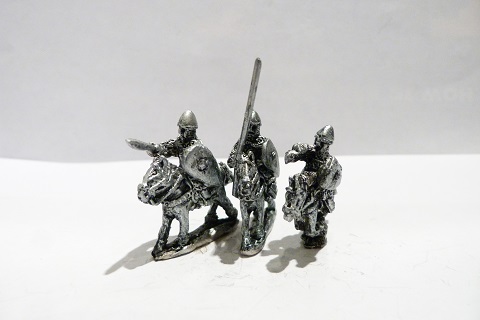 The infantry are all somewhere between 16mm and 17mm foot-to-eye, and quite chunky. The mounted men are larger still, mounted on steeds that are an average of just over 17mm to the withers. The casting quality is very good, with very little to no flash or mould lines on the models. The infantry are all somewhere between 16mm and 17mm foot-to-eye, and quite chunky. The mounted men are larger still, mounted on steeds that are an average of just over 17mm to the withers. The casting quality is very good, with very little to no flash or mould lines on the models.
Firstly, the monks. They are all wearing very simple clothes, appropriate for the mendicants who accompanied the Crusades. One man holds a massive book under one arm - presumably a Bible, and the other heaves with him a casket, no doubt protecting a saint's bones. The third prays forebodingly with his hood up, and the fourth holds his cross for strength while warding off some enemy with his other hand.
The Saracens wear loose trousers and turbans, some with short robes and others in chainmail. Their weapons are heroically scaled, and the foot pack contains quite a nice irregularly-shaped horn. In an interesting design choice, the mounted pack includes one man communing with a small bird resting on his hand, presumably a reference to Saladin's famously peaceful demeanour outside of battle. Their shields are all small and round, though some are more ornate than others.
The first Crusader pack I picked up was of an oft-neglected unit - the Turcopoles, Christianised natives and Armenians who provided the heavy knights and men-at-arms of Europe with light cavalry and scouts. They wear the characteristic Byzantine-style conical helmet, and are armed with a mix of spears and bows.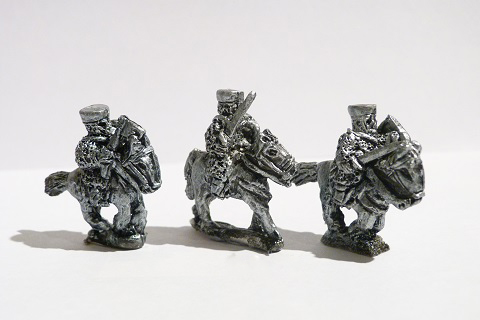
The heavy cavalry - whether used as knights or men-at-arms - are in long mail byrnies, with either nasal or cylindrical helmets depending on which pack you choose. They are generally armed with a mix of swords and axes, with one pack exclusively equipped with lances. Their shields are a mix of kites and the more modern heater type. There is a range of poses in each pack, with the command set being the most varied.
The horses of both factions are serviceable, if a little roughly made. None of their tack looks out of place for the period, and the sculptor has kept them bare instead of putting them in the sort of overdone, out-of-period barding that would see them drop dead in the desert heat.
The sculpting is not in the market's upper tier, but then again neither is the cost of adding these models to your collection. Lancashire Games are famous for the amazingly low "per model" cost of their discount battle packs, and there is no reason to assume that this new line will not follow the same practice - though at the time of writing, they are only available to those who pre-ordered. The Franks have a very large array of knightly models, supported by heavy infantry, turcopoles and sergeants, while the Saracens have a typical mix of ghulams, light cavalry and different types of infantry - all you need to get started with the Crusades in the Holy Land or Spain! And with the new SAGA: Crescent and Cross appearing, it is the perfect time to start a new army in this period using God's Own Scale.
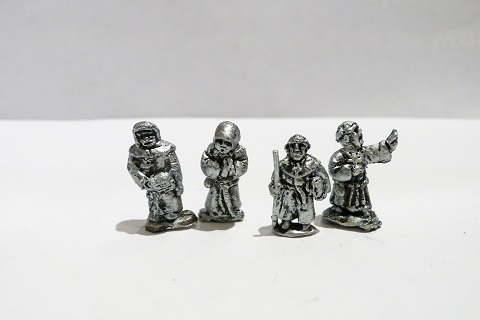 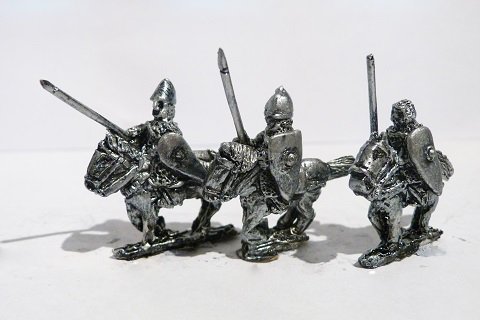 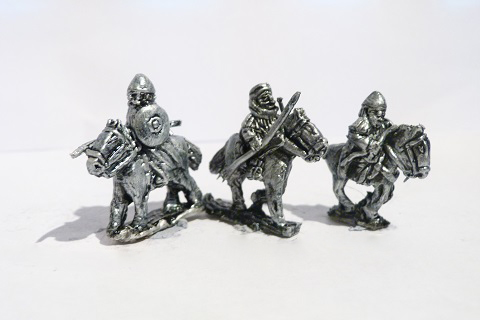
|
| Since I am a big fan of Afghanistan and the North-West Frontier during the Victorian colonial period, the new range called the "Northwest Frontier" from Studio Miniatures is another welcome addition.
All figures are made of white metal, supplied unpainted, and average about 28mm in height from sole of foot to eye (about 20mm for kneeling figures). They are very cleanly cast and the anatomy is very good, on moderate bases, which is good for basing purposes. Overall, these are well-sculpted figures.
Style-wise, they will fit in well with those offered by other companies. For example, anyone that has North-West Frontier figures from Foundry and/or Old Glory will be happy to add these figures as well as the new range from Artizan Designs to the mix. Any difference in scale are minor (even for the older Foundry tribal figures), and when painted and based it will most likely be difficult to tell the difference (a big plus for companies, in my opinion). This new range is another must-buy if you are wargaming the Afghan Wars or North-West Frontier, and these figures should paint up nicely and give variety to any you already have. After all, tribal war bands should look irregular in poses and such, and adding in figures from different companies is a great way to achieve this.
With regard to the dress of these tribal figures, all are sculpted wearing classic clothing items and equipment that reflect contemporary period drawings and accounts of Afghan and Pathan tribesmen - exceptionally well done! All are wearing an angarka (smock) with trousers ranging from wide-legged to the partig style gathered at the ankles, plus footwear of either chapplis (sandals) or slipper-types with some being barefoot.
However, all of the figures are wearing the seemingly ubiquitous poshteen (sheepskin leather coat, worn with the fleece towards the body), although historically not every tribesman would have owned or worn one (only really worn for warmth, so should not be seen in summer months). Wealthier tribesmen, such as a Malik or a Khan (leader types), would have worn a poshteen that was often highly embroidered, sometimes in silver or gold thread, on the outside. Hopefully some future packs will be done without poshteens, to add variety to the selection.
Headwear represented on these figures is either a pagri (turban) or small round skullcap. A couple of the turbans even have the kullah (small pointed cap) sticking out - very nice - with some having one end trailing down the back or front of the figure. Many of the figures have a lungi worn as a sash or type of cummerbund.
Many of the figures were supplied with shields, which are the small round dahl type, often seen with metal bosses on them. These are either on their left arm if wielding a sword, or slung on their backs if using a jezail (a very nice touch). Lastly, all swords should be bent slightly, to give them the proper scimitar-shaped look of a tulwar.
The musket-armed figures represent those armed with a long-barreled matchlock or flintlock musket - the jezail. Since the jezail was disappearing as the tribesmen became better armed, especially by the 1890s period, it is unfortunate that no figures were made using breechloaders, but possibly this is planned for the future.
Three packs are currently available, but only the following two packs were available for review. All figures reviewed were wearing the standard angarka (smock) and trousers, a poshteen, plus footwear and a waist sash. Therefore I will only comment on the type of headwear worn (turban or cap).
NFA001 - Afghan Tribal Command (3 figures): One figure is a drummer, wearing a cap, kneeling. While I do not generally like kneeling tribal figures that are not shooting, this drummer seems to fit in nicely with a serious expression and a very nice pose, using both hands to beat each side of the drum that is slung around his chest.
One figure is a Malik (clan leader or headman) wearing a turban (over a kullah cap) with the ends down his back; tulwar in right hand waving it above his head, and shield in his left hand; knife thrust in waist sash and jezail slung on back - another great figure.
One figure is a standard-bearer wearing a turban with the ends wrapped around his face (only eyes and top half of nose visible), standing left foot forward, in his right hand a tulwar, point down on the ground, with his left arm outstretched and slightly bent, hand in a fist able to take a standard pole (after you drill out the hand to allow a hole for the wire pole); shield slung on back - very nice.
NFA002 - Afghan Tribesmen Advancing (4 figures): Two figures are armed with jezails, and two are armed with tulwars.
One figure is wearing a cap, advancing with right foot forward and carrying his jezail at ready (port); ammo pouch on belt with knife tucked into belt. One figure is wearing a turban around a kullah cap, advancing with left foot forward, with jezail at the ready (port); knife is tucked in belt and shield slung on back.
One figure is wearing a skullcap, advancing with left foot forward, with tulwar in his right hand about waist level and carrying a readied shield (with a very nice scowl on his face!). One figure is wearing a turban with the ends down his back, advancing with right foot forward, tulwar and shield readied at his waist; jezail slung on his back.
In conclusion, I think anyone who likes the Afghan wars and the North-West Frontier can all agree that these are nicely done miniatures, which should be in everyone's colonial collection. These figures are highly recommended. Bob's your uncle!
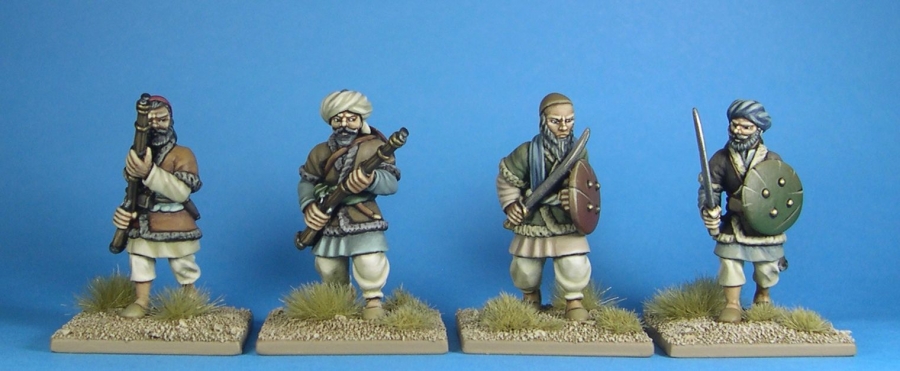 |
| Studio Miniatures has added to their "Northwest Frontier" range, all being figures of British infantry during the 1890s period, including officers (on foot and mounted), command (drummers/buglers/NCOs), and infantry packs. All are in late-1890s uniform and equipment, suitable for the myriad of North-West Frontier actions and campaigns during the 1890s (such as the Pathan Revolt, 1898-99); they could also work for the Re-Conquest of the Sudan (1896-99), and possibly even the Boer War (1899-1902) as well.
The figures are made of white metal, supplied unpainted, and average about 28mm in height from sole of foot to eye (about 20mm for kneeling figures). They are very cleanly cast and the anatomy is very good. All figures are on moderate bases, which is good for basing purposes. Overall, these are well-sculpted figures.
Style-wise, they match up very well with the old Foundry, Old Glory, and with the new Artizan Designs of the British 1890s period figures. The differences in scale for the older Foundry figures are minor such that when painted and based it would be difficult to tell the difference (a big plus for companies, in my opinion). Detail is nicely emphasized without being exaggerated. Personally, I really like how smooth the uniforms and detail is - no rough spots that I could find. Very importantly, the mold lines are expertly placed (a skill often overlooked by some figure companies), allowing them to seemingly "flow" into the right angles and areas for the figure pose, and any lines were very slight and easy to file off.
All figures are in the 1890s uniform, including a Foreign Service (Sun) helmets with chin-straps clearly visible on all helmets just on the brim. There are no neck curtains on the helmets, which is good, since they were not generally universal. A slight quibble (if just) is that the puggarees on the helmets have no lines on them to show the wrapping, but are easy enough to add with a couple black lines during painting. All figures have the epaulettes easily seen on the shoulders of their coats and are large enough for adding piping during painting if desired.
The infantry figures are wearing puttees over boots, with standard coat and trousers, and have a rolled greatcoat topped by a mess-tin on the middle back of the valise (Slade-Wallace pattern) equipment used at the time. Ammunition pouch is visible, as well as haversacks and water-bottles, with bayonet scabbard just visible (and nicely placed) beneath the haversack. Interestingly, and one wonders why, these figures are carrying what appears to be a water-bottle that looks similar to the one used in WWI or later (being a bit rectangular), rather than the 1888 style (Mk IV), which was round and felt-covered, that was coming into use and universal by 1897 (admittedly, this is only a slight quibble, and will go unnoticed by most). The infantry figures are all armed with a Lee-Metford rifle, but none have any bayonets fixed.
Eight packs are currently available, but only the following three packs were available for review. Rather than point out all the standard uniform and equipment, I will only point out differences on the individual figures that vary from what has already been stated above.
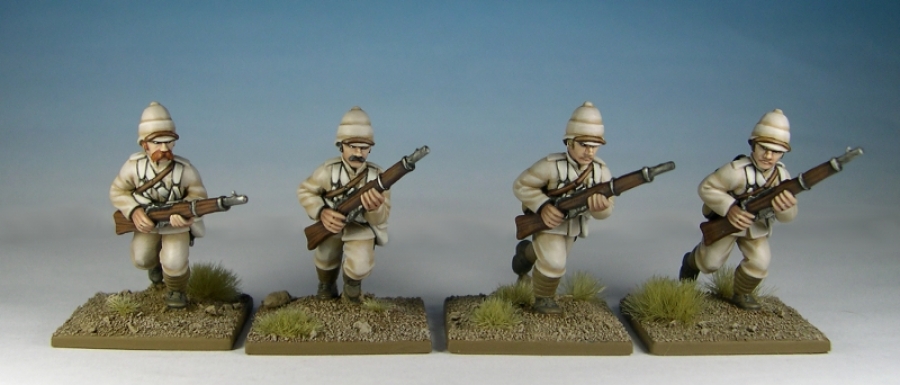
NFB001 - NWF British Infantry Officers (3 figures): Overall, a nice collection of British officer figures, and very useful as they are generally different poses than what can be found from other companies, and will compliment other figures as well.
One figure is walking (left foot forward), wearing puttees, sporting a Victorian-style mustache complete with nicely sculpted lines that show the hairs of the mustache - fantastic! He is reaching with his right hand for his revolver from his holster on the left side of his Sam Browne belt (no ammo pouch is visible), with a haversack on left hip. A very nice touch is that he is carrying a swagger stick (baton) in his left hand, down against his left leg - no doubt ready to slap it against his puttee in displeasure at what he sees! This really is a great figure to use as a commanding officer.
One figure is running (right foot forward), wearing puttees, pointing his pistol in his right hand, while holding his sword scabbard with his left so as to keep it from tripping him since his sword is sheathed - any sword-wearing re-enactor will know what I mean! This figure has very nice animation and a great pose. He has a water bottle on his right hip, but no holster or ammo pouch, which I think is an unfortunate oversight. He really should have a holster and ammo pouch, though one could easily say the holster is being hidden by his left hand and sword hilt, so there is that.
One figure is standing, pointing with left arm extended and forefinger extended, holding a revolver in his right hand with the barrel back near the side of his head like he has just ordered "Get back, I'll cover you" - a very nice pose for an officer figure. Holster is on the right hip, with ammo pouch on left side, all on Sam Browne equipment belt. Interestingly, instead of puttees, this is the only figure that is wearing gaiters.
NFB004 - NWF British Infantry Running (4 figures; only 3 figures were included in pack for review): All figures are advancing with their rifle at the ready. Not much more needs to be said about the poses, as they really are correct. One thing however, is that one of the figures sports a nice drooping Victorian-style mustache, like the officer figure reviewed above.
NFB007 - NWF British Infantry Loading (4 figures): One figure is kneeling loading; throwing the bolt on his rifle that he is holding with his left hand. One figure is standing; drawing a bullet from his ammo pouch, with rifle held in left hand and rifle-butt resting on ground. One figure is standing loading, drawing a bullet from his ammo pouch, holding his rifle in his left hand and balancing it so that it is at ‘ready' - very nice pose. One figure is standing loading, throwing the bolt on his rifle that he is holding with his left hand while looking down at what he is doing. Overall, a nice collection of infantry loading poses.
I cannot wait to see how these figures paint up, which will no doubt be quickly as khaki uniforms are a breeze to paint. Bob's your uncle!
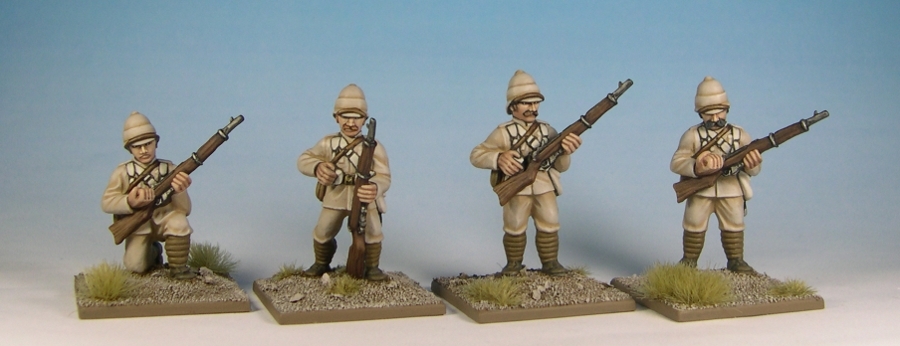 |
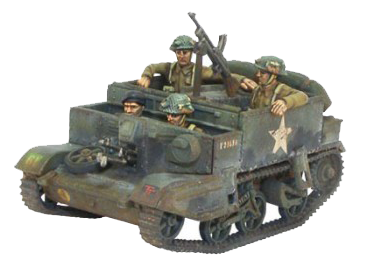
|
1/56th Scale British Universal Carrier
Warlord Games
Reviewed by Wayne Bollands
|
Under the Bolt Action banner, Warlord Games have released a plastic universal carrier that is perfect for the wargames table. The kit comprises of two sprues with enough parts to construct a basic version of the British and Commonwealth Universal Carrier. The Universal Carrier, also known as the Bren Gun Carrier from the light machine gun armament, is a common name describing a family of light armoured tracked vehicles built by Vickers-Armstrong and other companies. The first carriers - the Bren Carrier and the Scout Carrier with specific roles - entered service before the war, but a single improved design that could replace these, the Universal, was introduced in 1940.The vehicle was used widely by British Commonwealth forces during the Second World War. Universal Carriers were usually used for transporting personnel and equipment, mostly support weapons, or as machine gun platforms. With some 113,000 built by 1960 in the United Kingdom and abroad, it is the most produced armoured fighting vehicle in history.
And, due to being a plastic kit, Warlord can probably produce just as many! The main components are very well moulded and contain a nice level of raised detail where required, most notably the rivets. The tracks look accurate and have a slight amount of ‘sag' to appear more realistic. The sprue comes with two crew and two ‘riders', all of which have separate heads. A nice touch is that the two riders are depicted with their arms across the sides of the rear compartment, looking quite relaxed. Although the crew is dressed for NW Europe, a simple head swap and suitable paint colour will place them in other theatres. Two Bren guns are included as armament, one for the passenger position at the front of the vehicle and the other on an anti-aircraft stand for use in the rear passenger section. There are also some ‘extras' in the form of a folded camouflage net or tarpaulin, a stowage box or two and a spare roller for the tracks. Although a simple kit in appearance and easy to put together, this simplicity belies the level of detail that has gone into its creation. The fact that it is available in plastic, at the right scale and a good price, means you are able to very quickly build up a carrier platoo. A good quality, welcome addition to the 1/56th / 28mm WW2 market and one which is to be recommended
|
|
The Winter War
The Winter War
Reviewed by Matt Morran
The Winter War is a new reprint of an eighties classic from the popular
Stackpole Military History Series, written by Eloise Engle and Lauri
Paananen and covering Finland's odds-defying 105 days of resistance to
the Soviet Red Army from November 1939 through to March 1940. The
authors are supremely qualified to have written this book. Ms Engle was a
journalist specialising in military affairs and recipient of the White
Rose of Finland, the highest award given to foreigners. Mr Paananen
actually served with the Finnish Home Guard during the war itself.
|
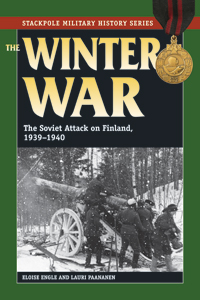
|
|
The book is written in an almost "story" style, taking the reader from Stalin's initial pseudo-negotiations all the way through to the bitter end. It is immensely readable and flows easily from the strategic to the personal level and back again. The short bibliography is supplemented by dozens of quotes from interviews with surviving veterans, all of which serve to create an impression of the realities of this particularly brutal conflict. Contemporary Finnish newspaper cartoons and a couple of dozen black and white photographs also provide their thousand words apiece to illustrate the Finnish side of the war.
Like all asymmetric conflicts, this was a war conducted with a brutal callousness almost unimaginable to modern civilians. This book brings it all to life without undue graphic detail. The blunt blitzkriegs of the Russians and their armour, the dogged defence and pragmatic motti tactics of the lightly-equipped Finnish troops - all the important aspects of the Winter War spring off the page thanks to Engle & Paananen's lively prose. The honour that Field Marshal Mannerheim's Finns displayed despite their desperate circumstances shines through in multiple stories of almost tender treatment of Russian POWs, sometimes mere minutes after the merciless annihilation of the rest of their brothers in arms.
Given the authors' identity, the fact that the war is largely narrated from the Finnish side is understandable. That said, there are several snippets from the Russian side, generally to enhance the narrative irony of their account. It shows why and how Finland's struggle was a cause celebre at the start of World War Two, as well as why it has kept that reputation, despite her later alliance with the Axis powers.
Despite several maps and personal accounts of frontline combat, this is not exactly a wargaming book. It is a thoroughly enjoyable work of military history that will have an important place on my bookshelf, but the meat of it charts a course too abstract to have a concrete effect on the things wargamers care about; uniforms, small unit tactics - all the minutiae of war. That said, for those willing to use "tactical snippeting" to mine information from the text it could provide several interesting historical scenarios for company or battalion actions. I would certainly recommend it as a primer on the Winter War for those attracted by the recent releases concerning it for games like Chain of Command and Flames of War. It is available discounted from several online outlets across the world, and in my opinion worth the RRP as well.
|
Last Updated On Tuesday, September 2, 2014 by Mark at Wargames Illustrated
|
|
|